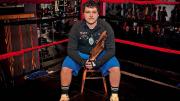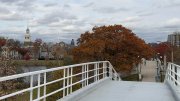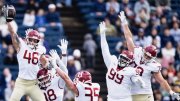“I got punched in the head an hour ago,” says Victor A. Lopez-Carmen, M.D. ’24 (known as Waokiya Mani in the Dakota language and Machil in the Yaqui language). “I knew it was going to happen at some point, and today was the first day I got rocked.” He’s just come from a boxing lesson at Redline Fight Sports in Central Square, where he’s been training for the Haymakers for Hope (H4H) charity boxing match.
Today, he practiced defensive maneuvers (“Which explains why I got punched in the head,” he laughs), and tomorrow it will be footwork. H4H sponsors him to train daily, early in the morning or late at night after his Harvard Medical School (HMS) clinical rotations. All that practice will be put to the test on May 11, when he and 29 other novice fighters spar in front of 2,000 people at Boston’s MGM Music Hall to raise money for cancer research. Lopez-Carmen—who is Yaqui on his mother’s side and an enrolled member of the Crow Creek Sioux Tribe on his father’s side—is fighting in honor of Yaqui jeweler Paros Baltazar, a member of his tribe with cancer. He says, “I want to be helpful to my community. This is a way for me to help.”
The boxing match is just one particularly out-of-the-box way that Lopez-Carmen has been helping. This year, he was named to the “Forbes 30 Under 30” list in healthcare for his work expanding access to medical treatment and careers for Indigenous people: developing recruitment pipelines for Indigenous physicians at Brigham and Women’s Hospital; working with HMS to develop clinical rotations on the Pascua Yaqui reservation in Arizona; co-chairing the United Nations’ Global Indigenous Youth Caucus; and during the pandemic, establishing a nonprofit that translated COVID-19 health information into more than 40 Indigenous languages.
“I’ve always been very clear about my intention that, after I leave medical school, I’m going to go back to my communities and be a physician,” he says. He plans to be a pediatrician for Native children: “I know how much it means to Native families to have Native physicians taking care of them. And if you go one step further, how much it means to Native families to have someone in their tribe who can speak some or all of the language and understand their culture.” Lopez-Carmen is learning Lakota, the language spoken by one of his tribes, to provide the kind of comprehensive care currently lacking in the healthcare system. “I want to go back to work in my communities and be able to influence that on-the-ground, community-level change,” he says. “For me, the question—the only question—is, which of my communities do I go to first?”
“For me, the question—the only question—is, which of my communities do I go to first?”
The topsoil on the Pascua Yaqui reservation is loose and sun-bleached, ready to cough up dust at the slightest provocation. As children, Lopez-Carmen and his friends kicked up clouds of it as they ran across the ceremony grounds, stopping at food booths for frybread (fried flatbread), Indian tacos (tacos served on frybread), and snow cones. He lived near the reservation on the south side of Tucson, and he’d come after school while his mom finished work at a tribal cultural-preservation nonprofit. He was also always there for ceremonies, where his stepfather performed as a traditional dancer.
His mother went back to school for her undergraduate and nursing degrees when Lopez-Carmen was young. “I graduated from high school the same year she graduated from nursing school,” he says. Medicine runs even further back in his lineage: his grandmother was a midwife, and his great-grandfather in Dakota kinship customs was the first Native man to be certified as a medical doctor in the United States,—Ohiyesa (“Always Victorious”) was also known as Dr. Charles Eastman.
Lopez-Carmen was inspired to a medical career by those relatives—and because he saw how difficult it was for his community to access quality healthcare. “I didn’t know any Native physicians growing up. I realized how poor our health was in my community, how many health disparities we had as Native people,” he says. “I felt like the odds were stacked against us systematically.”
The numbers suggest that’s the case. The Indian Health Service (IHS), which provides healthcare for most tribal nations, offers only about half the healthcare dollars per capita that other government-funded medical programs like Medicare and Medicaid spend. Native Americans have a lower life expectancy and higher rates of chronic disease compared to other ethnic groups in the United States. The Yaqui have some of the highest rates of diabetes in Arizona, and often experience extreme forms of the disease that require amputation. “I saw a lot of that growing up,” Lopez-Carmen recalls. “Those manifestations were kind of normal to see, and you realize how people in your community aren’t living as long as people in other communities.”
He moved around as a child, to Chickaloon Native Village in Alaska, and then to “rural, rural, rural” Schuyler, Virginia—the town upon which the setting of the television show The Waltons is based. He went to Ithaca College, and subsequently won a Fulbright Scholarship to pursue a master’s of public health degree at Western Sydney University in Australia, where he researched Indigenous health equity among Aboriginal youth. Then in 2019, he enrolled at HMS—and realized he was one of two Native students in his class.
Unfortunately, two Native students in one medical class is far better than the national average. The Association of American Medical Colleges reported in 2018 that 43 percent of medical schools enrolled zero Native students and only 9 percent enrolled four or more. Of the nation’s more than one million practicing physicians, less than 0.4 percent are Native. For Lopez-Carmen, this signals a broken pipeline: “Looking back on how I got to medical school, sometimes I think it could have easily gone wrong. I’ve seen where some of the pitfalls along the path can be, and I want to help Native youth be able to get here, if that’s what they want.”
Working alongside assistant professor of emergency medicine Valerie Dobiesz, an emergency medicine physician at Brigham and Women’s, he’s developed the Ohiyesa Premedical Program (named in honor of his great-grandfather). The initiative, designed to be a one-year pilot, brings Indigenous students and alumni from community and tribal colleges to shadow physicians, scrub for surgeries, accumulate more than 50 hours of clinical exposure at HMS and Brigham and Women’s, and deliver presentations about Indigenous health to doctors. Now, to have an earlier impact on Native educational paths, the program has been redesigned for high school youth at Navajo Nation.
"If you live on a reservation or are Native, the barriers to good health are so much more extensive than people realize, and who we are is so much more than people realize.”
Lopez-Carmen hopes his work as a physician and activist can fill the gaps that keep Native communities from accessing needed healthcare. “One of the misconceptions other people have is that Indigenous people are in poor health because of our culture, that the stereotypes are inherent to who we are,” he says. “People say, ‘If they stopped drinking, if they stopped smoking, they would be healthier.’ But if you live on a reservation or are Native, the barriers to good health are so much more extensive than people realize, and who we are is so much more than people realize.” Many reservations are in food deserts and, according to 2021 Census Bureau data, one-fourth of Native people live in poverty (compared to about one-tenth of white people). “Poverty compounds everything else,” Lopez-Carmen observes. “If you’re in a food desert, you need a car to get food. A lot of people don’t have cars, don’t have money for gas, don’t have money for food. It all builds upon one another. I’ve seen people struggle.”
Last year, before the start of his third year at HMS, one of his tribes called him home. The Crow Creek Sioux tribal government wrote a letter to HMS saying they needed Lopez-Carmen to return for a year to take part in ceremonies and be with his community. HMS granted the leave of absence, and Lopez-Carmen lived in South Dakota, learning the Lakota language. “The time I spent there is going to help me in that the more connected I am with my communities, the better the physician I’m going to be,” he says. “We all have to go through the same licensing exams and learn medicine itself, but there’s this whole other curriculum that I realized I have,” founded in Indigenous cultures and languages.
At Harvard, he’s balanced his commitments as a student with his commitments to his tribe. “The standard at Harvard Med is to put your head down, study, and don’t speak up, but my time has been sort of unusual,” he says, as responsibilities to his communities take him home every few months. “From a nationhood perspective, I feel like I have an ambassador role,” he says. “Not that I’m the representative of my community, but I feel like here at Harvard Medical School, I want to represent who we are the best that I can, even if it means going against the status quo.”
Soon, his fellow students will come to his community. Lopez-Carmen is working with the school to design a clinical rotation on the Pascua Yaqui Nation reservation in Arizona, where he used to play and eat snow cones as a child. “I think it’s important that these future physicians at Harvard Medical School are exposed to who we are,” he says. “Oftentimes, we’re the last people thought of—kind of like a footnote. I want these future physicians to have the experience where they’ve been with us on the reservation, with our people. I think it will go a long way.”
The rotation, still in development, will provide a unique window into Indigenous healthcare, as the Pascua Yaqui Nation has elected to manage its own healthcare system with federal funds, rather than using the Indian Health Service. “One of the cool things about our tribal health system is there’s a lot of integration of Yaqui traditional health and healing,” Lopez-Carmen says. “It’s important for students to know the value in that.”
On May 11, he’ll don his gloves and enter the boxing ring, a representative of the Yaqui and Crow Creek Sioux Tribe. Perhaps some of his sparring will live up to his Yaqui name, Machil (“Scorpion”). But maybe the fact that he’s in the ring at all, fighting for a member of his tribe, embodies his Dakota name, Waokiya Mani. The direct translation is “Walks Helping.” More precisely, however, it means, “My way of life is to help.”









